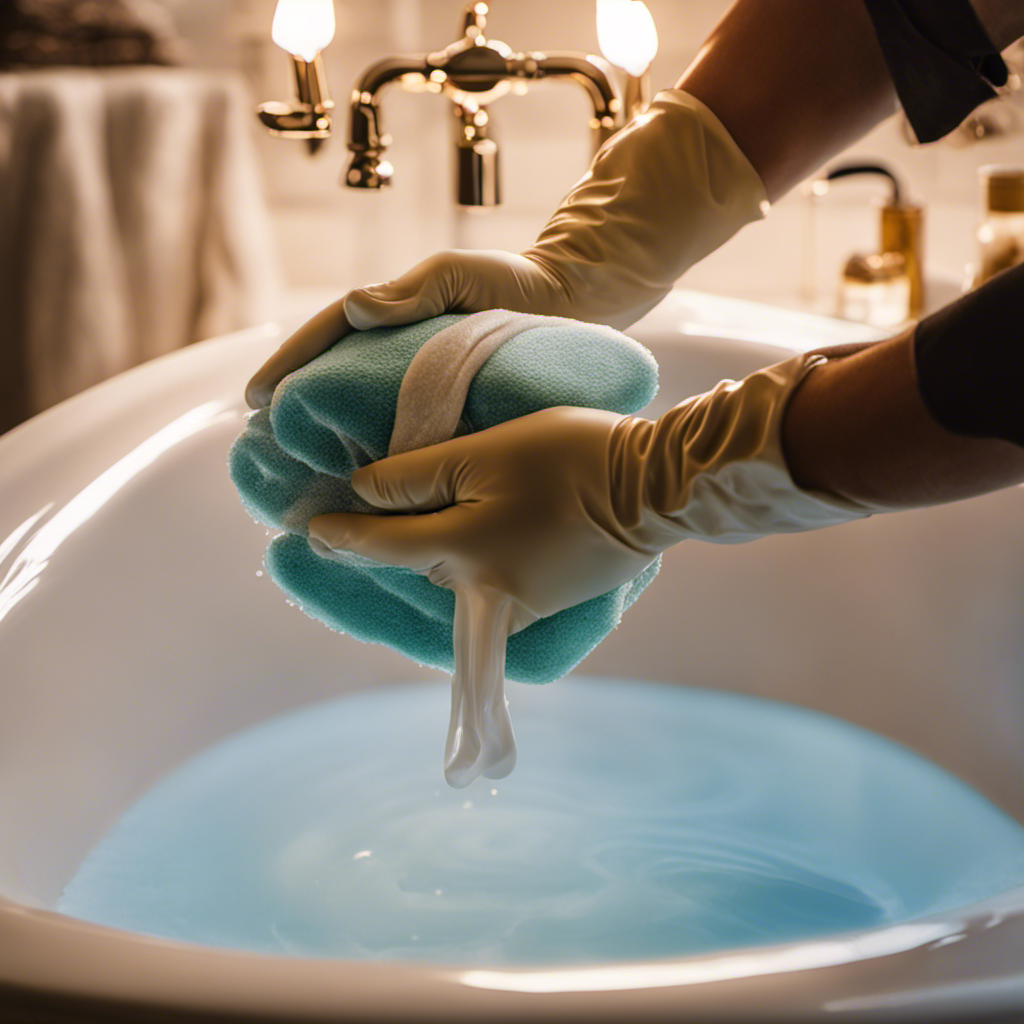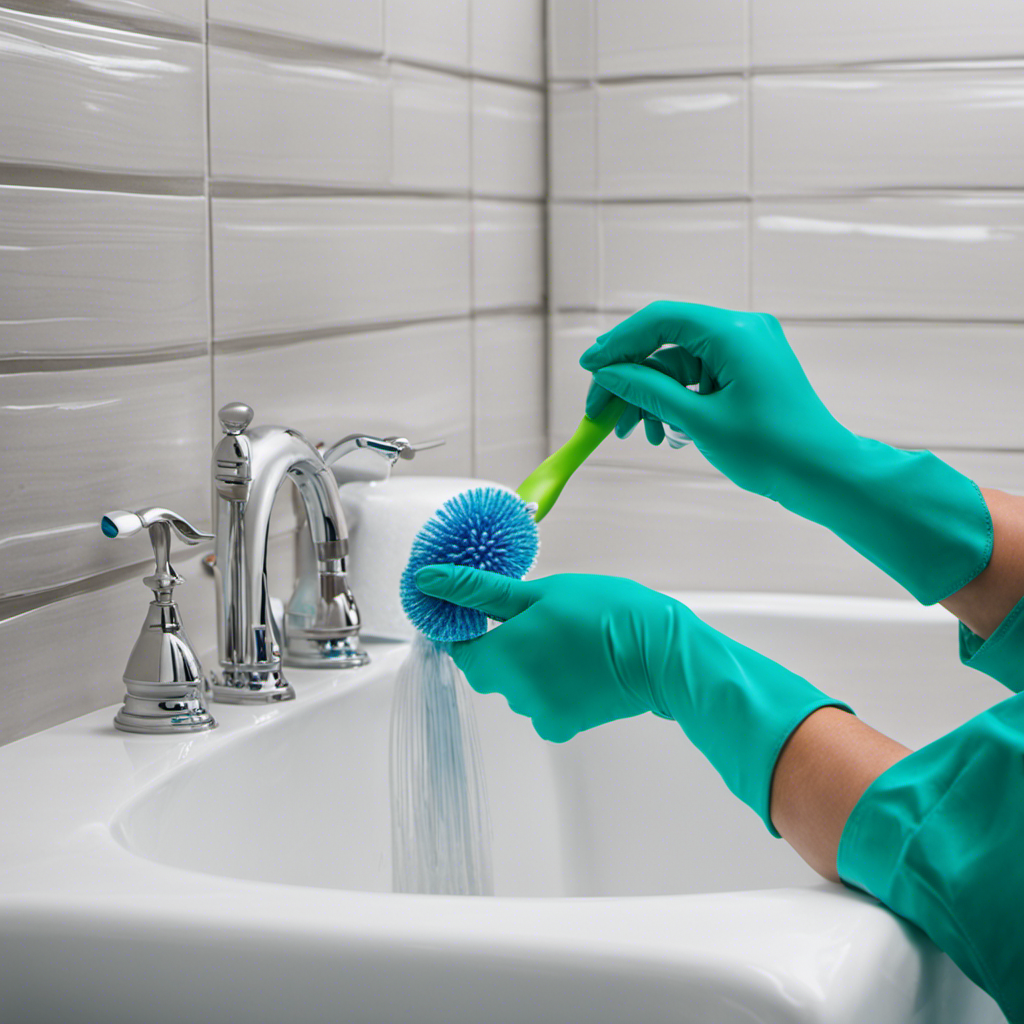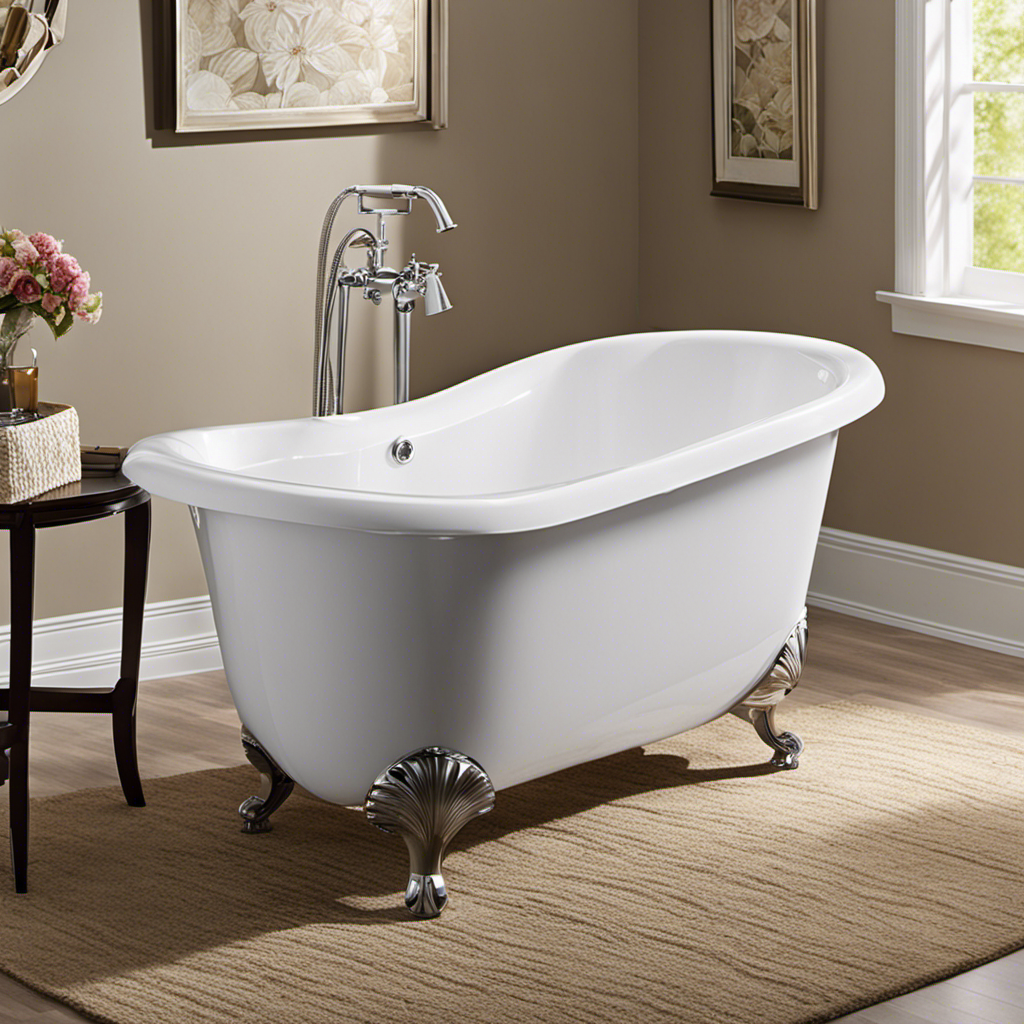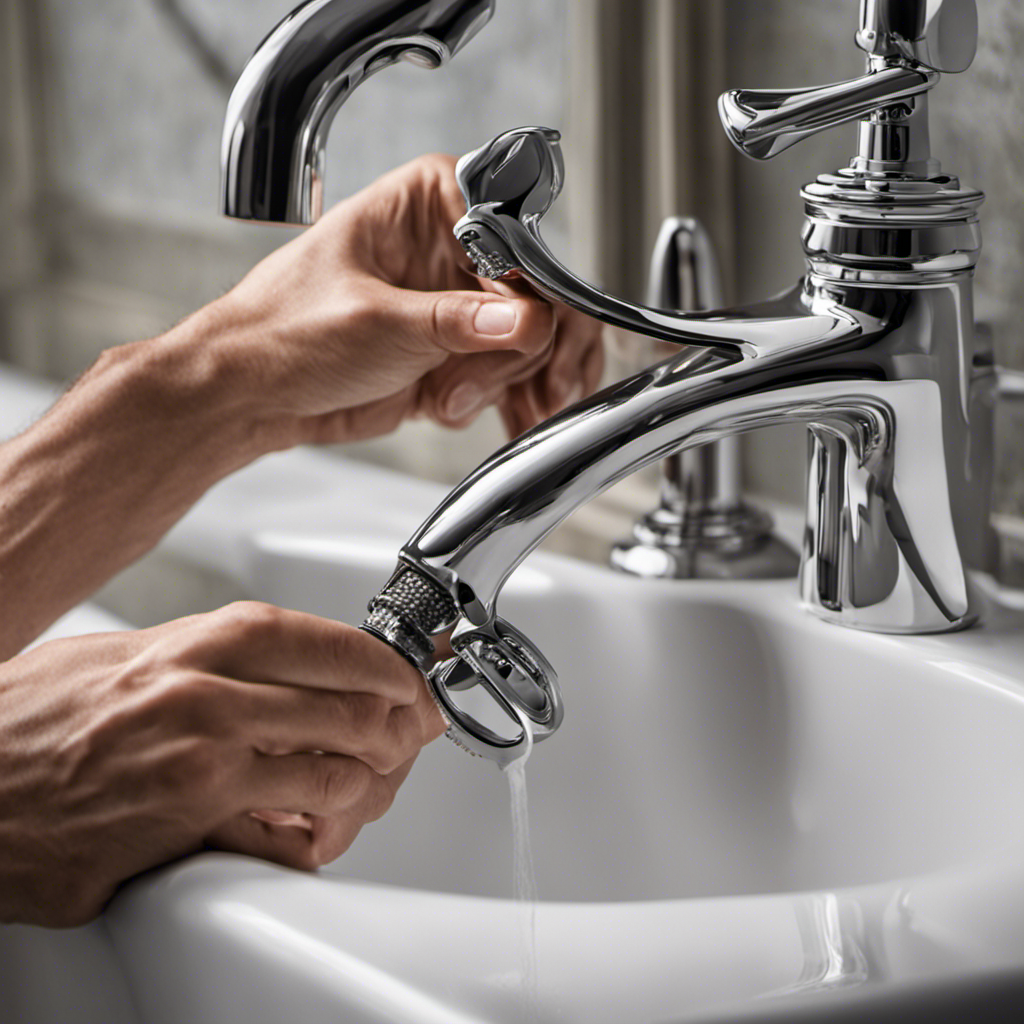Are you tired of staring at a less-than-sparkling porcelain bathtub? Well, fear not, my friends! I’ve got just the solution for you.
In this article, I’ll guide you through the steps to achieve a squeaky-clean bathtub that will make you feel like you’re bathing in luxury. With a few simple techniques and some natural cleaning solutions, you’ll be able to banish stains and build-up in no time.
So, let’s roll up our sleeves and get ready to transform your bathtub into a pristine oasis.
Key Takeaways
- Gather necessary cleaning supplies such as a soft sponge or cloth and a mild cleaning solution for porcelain surfaces.
- Follow safety precautions by wearing gloves and ventilating the bathroom.
- Use effective cleaning techniques to break down stains and build-up.
- Regularly wipe down the bathtub after each use and apply a porcelain-safe cleaner or wax for extra protection.
Preparing the Bathtub
First, gather all the necessary cleaning supplies.
To properly clean a porcelain bathtub, you will need a few essential cleaning tools. Start by grabbing a soft sponge or cloth that won’t scratch the surface of the tub. You’ll also need a mild cleaning solution specifically designed for porcelain surfaces.
It’s important to follow safety precautions when cleaning a bathtub, especially if you’re working with chemicals. Make sure to wear gloves to protect your hands from any potential irritation or allergic reactions. Additionally, ventilate the bathroom by opening a window or turning on the exhaust fan to avoid inhaling any fumes.
Removing Stains and Build-up
To effectively remove stubborn stains and build-up from a porcelain bathtub, it’s important to use the right cleaning products and techniques. One common issue many people face is rust stains on their bathtub. To tackle this problem, I recommend using a rust removal product specifically designed for porcelain surfaces. These products contain chemicals that break down the rust and make it easier to remove.
When using these products, be sure to follow the instructions carefully and wear gloves for protection. Additionally, effective cleaning techniques such as scrubbing with a soft brush or sponge and using warm water can help to remove other types of stains and build-up.
Now, let’s explore using natural cleaning solutions to maintain the cleanliness of your porcelain bathtub.
Using Natural Cleaning Solutions
One option you have for maintaining the cleanliness of your porcelain bathtub is to try using natural cleaning solutions. These alternatives are not only effective but also eco-friendly, making them a great choice for those who are conscious about the environment.
One popular natural cleaning solution is a mixture of baking soda and vinegar. Simply sprinkle baking soda over the surface of your bathtub and then spray vinegar on top. The combination will create a gentle foam that helps to remove dirt and grime. Let it sit for a few minutes before scrubbing and rinsing.
This natural cleaning method is not only safe for your porcelain tub but also for your health and the environment.
Now, let’s move on to the next step: scrubbing and rinsing.
Scrubbing and Rinsing
Now, it’s time for you to start scrubbing and rinsing using a gentle sponge or cloth.
When it comes to scrubbing techniques, it’s important to be gentle yet effective. Start by applying a non-abrasive cleaner to the surface of the porcelain bathtub. Using a circular motion, scrub away any stains or dirt, paying extra attention to the areas that are more heavily soiled. Remember to rinse the sponge or cloth regularly to avoid spreading dirt around.
As for proper rinsing, make sure to use warm water and thoroughly rinse away all traces of the cleaning solution. This will prevent any residue from being left behind and ensure a sparkling clean bathtub.
Dealing With Tough Stains
When it comes to stubborn stain removal, there are a few tried and true methods that I’ve found to be the most effective.
I’ll be sharing some tips and techniques that have worked for me in the past, so you can tackle even the toughest stains with confidence.
Additionally, I’ll also be discussing preventive measures that can help you avoid future stains and keep your surfaces looking clean and fresh.
Stubborn Stain Removal
To effectively remove stubborn stains from your porcelain bathtub, start by making a paste with baking soda and water. This natural remedy is a great bleach alternative and safe to use on porcelain surfaces.
Here are some steps to follow:
- Apply the baking soda paste directly to the stained area.
- Let it sit for about 15 minutes to allow the paste to penetrate the stain.
- Scrub the stain gently using a soft brush or sponge.
- Rinse the area thoroughly with warm water.
If the stain is particularly stubborn and doesn’t come off with the baking soda paste, you may need to consider professional cleaning options. A professional cleaner will have specialized tools and products to tackle tough stains effectively.
Once you’ve successfully removed the stubborn stains, it’s important to take preventive measures to avoid future stains.
Preventing Future Stains
If you want to avoid future stains, it’s important to regularly maintain and protect your porcelain bathtub.
One way to prevent rust stains is by keeping your bathtub dry after each use. Rust forms when water is left standing for too long, so make sure to wipe down the tub with a towel or squeegee.
Another common issue is hard water stains caused by mineral deposits. To avoid this, consider installing a water softener or using a vinegar solution to remove the stains.
Additionally, using a non-abrasive cleaner and a soft sponge or cloth can help prevent any scratches that can lead to stains.
Maintaining a Clean Bathtub
When it comes to maintaining a clean bathtub, there are two key points to consider: preventing soap scum buildup and choosing the right cleaner.
Soap scum buildup can be prevented by regularly wiping down the bathtub after each use and using a squeegee to remove excess water.
It is also important to choose the right cleaner that is specifically designed for removing soap scum and is safe to use on the bathtub surface.
Preventing Soap Scum Buildup
Make sure you regularly wipe down your porcelain bathtub to prevent soap scum buildup. Soap scum is a stubborn residue that can accumulate on the surface of your bathtub, making it look dull and dirty.
Here are some effective ways to remove soap scum and prevent mineral deposits:
-
Use a mixture of white vinegar and water to create a natural cleaning solution. Apply it to the affected areas and let it sit for a few minutes before scrubbing with a non-abrasive sponge.
-
Alternatively, you can use a commercial soap scum remover that is specifically designed for porcelain surfaces. Follow the instructions on the product for the best results.
-
To prevent mineral deposits, consider installing a water softener in your home. This will help reduce the amount of minerals present in the water, which can contribute to soap scum buildup.
Choosing the Right Cleaner
Using a commercial soap scum remover can be an effective way to clean and maintain the look of your porcelain bathtub. However, if you’re looking for alternative cleaners that are eco-friendly, there are several options available. These alternatives not only help you keep your bathtub clean but also minimize the impact on the environment.
| Cleaner | Ingredients | Benefits |
|---|---|---|
| Vinegar solution | Vinegar, water | Removes soap scum, kills bacteria, and leaves a fresh scent |
| Baking soda paste | Baking soda, water | Naturally abrasive, removes tough stains without scratching |
| Lemon juice | Lemon juice, water | Dissolves soap scum and leaves a refreshing citrus scent |
These eco-friendly options are not only gentle on your porcelain bathtub but also safe for you and the environment. Give them a try and see how effective and satisfying they can be in keeping your bathtub clean and shiny.
Conclusion
In conclusion, keeping a porcelain bathtub clean is essential for maintaining its beauty and functionality.
By following the steps outlined in this article, you can easily remove stains and build-up using natural cleaning solutions.
Regular scrubbing and rinsing will ensure a sparkling bathtub.
However, for those tough stains that seem impossible to remove, don’t worry! There are effective solutions available.
Remember, a clean bathtub not only enhances your bathroom’s aesthetics but also provides a soothing and relaxing experience.
So, take care of your porcelain bathtub and enjoy the blissful moments it offers.










